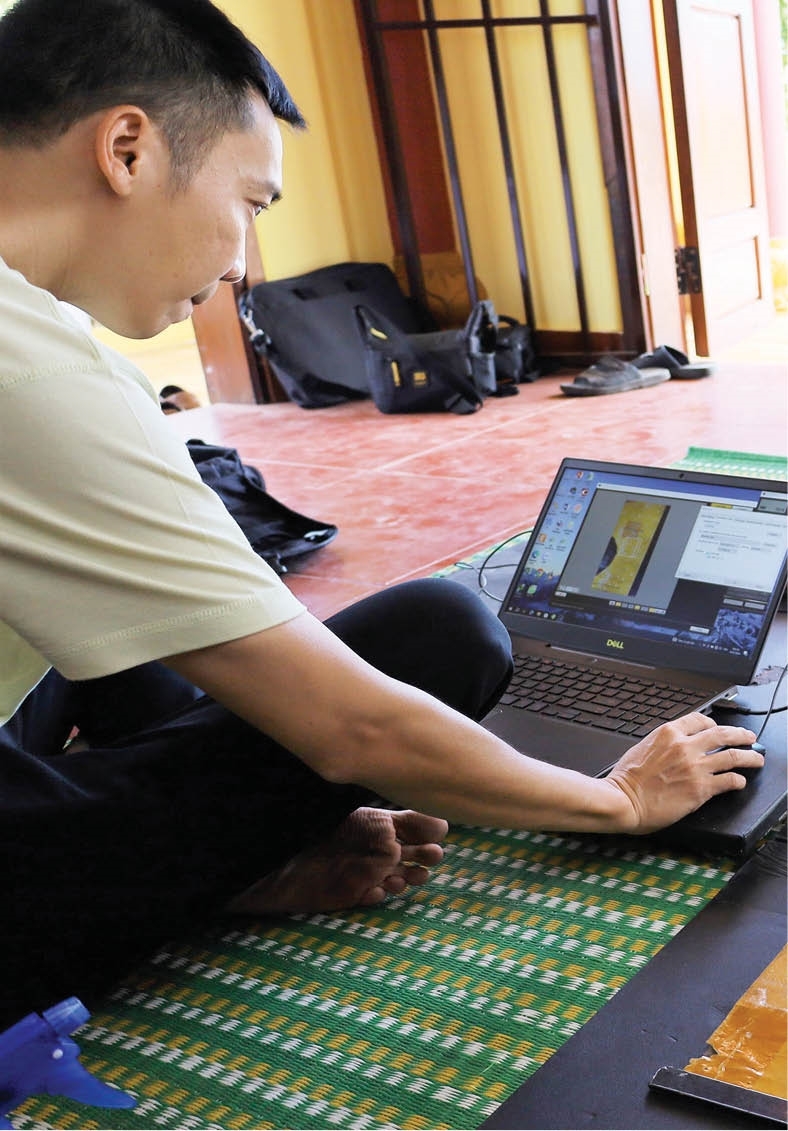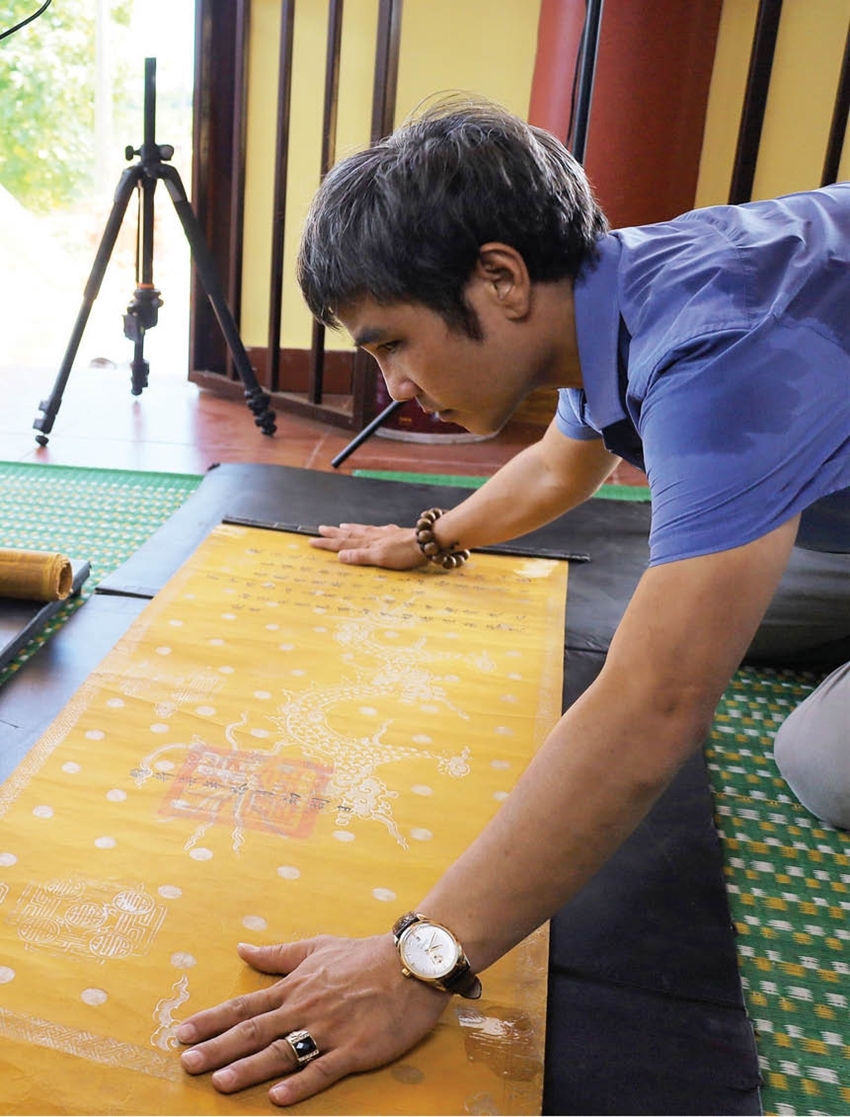 |
| Many valuable Han Nom documents in the province have been digitized and scientifically preserved |
Documents tracked
One day in the scorching summer heat, a group of officers of the Thua Thien Hue General Library, along with a "toolbox" were present at the Ha Lac Communal House, Quang Loi Commune (Quang Dien District). Located on the sandy land next to the Tam Giang - Cau Hai Lagoon system, this village still preserves quite a lot of Han Nom documents.
“We have been in long contact. Now with the consent of the village, clans, and elders, we decide to digitize the precious Han Nom documents in hope of long preservation,” an officer of the Thua Thien Hue General Library started the story.
Not now, but many years back before implementing the project for digitizing Han Nom documents across the province, a team of officers of the Thua Thien Hue General Library traveled throughout the villages of Hue, racing against time to preserve the precious documents bequeathed by the ancestors at risk of damage.
In the recently repaired Ha Lac Communal House, when the team of officers digitizing Han Nom documents arrived, the representatives of the village and clans in traditional ao dai had appeared very early. Offering incense at the altars, the elders solemnly performed rituals and prayed before lowering the chests containing documents so that the officers could begin the digitization process.
 |
| Many valuable Han Nom documents in the province have been digitized and scientifically preserved |
The wooden chests are covered with dust of time, but inside are the royal decrees or hundreds of pages of Han Nom documents that are assessed as the villagers’ treasures.
"From one generation to another, we have kept these documents until today. Now, thanks to the experts who translated and digitized them, we can preserve them and leave them for future generations to know more about our village and family," said a village elder, while carefully opening the chest. Inside, the dark yellow royal decrees rolled up were gently pulled out by the library officer. After more than 100 years of existence, the royal decrees remain intact. Above, the dragon image looms beautifully; the lines of words remain bold, large, clear, and balanced.
A Han Nom expert translated it roughly so that the elders in the village could understand the historical value and the meaning and time of conferment based on the information of the royal decree before passing it to Mr. Le Viet Tuan, Head of the Division of Professional Affairs and Technology, Thua Thien Hue General Library in order to start the processing and digitization.
Conservation in parallel with digitization
In turn, each royal decree was spread out and kept taut and flat in a fixed manner. Then Mr. Tuan and his colleagues used some specialized liquids and an iron to start treating the stains and dirt on the royal decree. This process is usually done very quickly to ensure the safety of the royal decree.
Mr. Tuan said that Hue is located in an area with a hot, humid, and rainy climate, so the Han Nom documents on paper were hit. Especially in low-lying rural areas, the documents over a hundred years old were not well preserved and not regularly checked, resulting in mold and tearing.
"There were times hardly had we opened the Han Nom document chest when these documents rotted like fine sand," Mr. Tuan recalled with regret.
According to Mr. Tuan, Han Nom documents in Ha Lac Village, although quite intact, are also under threat of damage over time if there is no scientific preservation method. Therefore, aside from preservation, digitization is needed. These documents will be stored on a digital technology platform to avoid losing the information contained in each document.
As for the damaged documents, Mr. Tuan said that by experience, logical restoration methods will be chosen to ensure the correct process. During that process, the owners of those documents will also be instructed on how to manage and preserve documents according to the correct techniques and standards to increase the longevity of the documents.
"After being digitized, the documents will be exhibited to the public. In addition, the CDs containing digitized Han Nom documents will be presented to the localities we supported in digitization," said Mr. Tuan.
According to Ms. Hoang Thi Kim Oanh, Director of Thua Thien Hue General Library, over the past 10 years, nearly 500,000 pages of Han Nom documents have been digitized. Predominantly among them are valuable documents such as royal decrees, royal orders, family genealogies, land registers, village young men’s registers, diplomas, administrative documents, literature books, history books, medical books, village regulations, prayer books, Buddhist scriptures, etc.
In 2024 alone, the unit digitized about 25,000 - 27,000 documents of these types at 50 family temples and private houses. This process has also received support and collaboration from the team of researchers and translators of Han Nom documents in exploiting and promoting the value of the documents.
"We also classify and catalog documents in accordance with the principles and methods of library studies. Besides, we determine the value, select and safely preserve the documents to increase their lifespan, serving the exploitation and use of documents at agencies, units, organizations and individuals in the province," Ms. Oanh shared and determined to do everything possible to limit the valuable Han Nom documents damaged and under threat of falling into oblivion.
